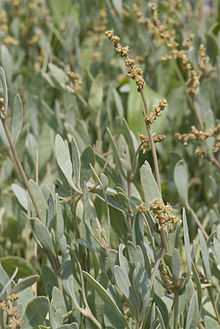Halimione
| Halimione | |
|---|---|
 | |
| sea purslane (Halimione portulacoides) | |
| Scientific classification | |
| Kingdom: | Plantae |
| (unranked): | Angiosperms |
| (unranked): | Eudicots |
| (unranked): | Core eudicots |
| Order: | Caryophyllales |
| Family: | Amaranthaceae |
| Subfamily: | Chenopodioideae |
| Tribe: | Atripliceae |
| Genus: | Halimione Aellen |
| Synonyms | |
|
Halimus Wallr. (nom. illeg.) | |
Halimione is a plant genus from the subfamily Chenopodioideae in the Amaranthaceae family. It is a sister genus of Atriplex and has sometimes been included in this genus.
Description
The species in genus Halimione are annual or perennial herbs with silvery grey stems and leaves. Their stems grow prostrate, ascending or erect. The leaves are opposite in lower part and alternate in upper part of the plants. The leaf blade is oblong with entire margins.[1]
Plants are monoecious. The spicate inflorescences consist of inconspicuous flowers. Male flowers comprise 4-5 perianth segments and 4-5 stamens. Female flowers have 2 totally concrescent, three-lobed bracteoles which enclose the ovary, a perianth is missing.[1]
The pericarp is tightly adherent to the inner side of the bracteoles, and also tightly adherent to the seed. The seed is vertically orientated, with a thin, membraneous seed coat. It is anatomically different from Atriplex (which has a brownish, thick and hard seed coat).[1]
Halimione pedunculata and Halimione verrucifera have a chromosome number of 2n = 18, Halimione portulacoides 2n = 36.[2]
Distribution
Halimione is distributed in Europe, North Africa, and Asia, ranging from Southwest Asia, and Central Asia to China (Xinjiang).[3][4]
Systematics
The genus has been first described in 1822 as Halimus by Karl Friedrich Wallroth (in Schedulae Criticae, p. 117). But this name was illegitimate, as there existed already Halimus Patrick Browne (1756) in family Portulacaceae. Paul Aellen replaced this illegitimate name by the valid name Halimione in 1938 (in: Verhandlungen der Naturforschenden Gesellschaft in Basel, 49, p. 121). Type species is Halimione pedunculata (L.) Aellen.[2]
During the following years, Halimione has sometimes been included in Atriplex. But phylogenetic research by Kadereit et al. (2010) revealed, that Halimione is a distinct sister genus of Atriplex.[1]
Halimione comprises 3 species in 2 sections:[1]
- Halimione section Halimione, with one species:
- Halimione section Halimus (S.F.Gray) Sukhor., with 2 species:
- Halimione portulacoides (L.) Aellen (Syn.: Atriplex portulacoides L.), sea purslane: at the sea shores of western and southern Europe, the mediterranean shores of North Africa to western Asia.[3]
- Halimione verrucifera (M.Bieb.) Aellen (Syn.: Atriplex verrucifera M.Bieb.): From eastern and southeast Europe (Romania, Ukraine) to Southwest Asia and Central Asia to China (Xinjiang) [4][5]
References
- ↑ 1.0 1.1 1.2 1.3 1.4 Gudrun Kadereit, Evgeny V. Mavrodiev, Elizabeth H. Zacharias & Alexander P. Sukhorukov: Molecular phylogeny of Atripliceae (Chenopodioideae, Chenopodiaceae): Implications for systematics, biogeography, flower and fruit evolution, and the origin of C4 Photosynthesis. In: American Journal of Botany, Volume 97 (10), 2010, p.1664–1687.
- ↑ 2.0 2.1 Halimione at Tropicos, accessed 2013-07-11.
- ↑ 3.0 3.1 3.2 Uotila, P. (2011): Chenopodiaceae (pro parte majore). – Halimione In: Euro+Med Plantbase - the information resource for Euro-Mediterranean plant diversity.
- ↑ 4.0 4.1 Gelin Zhu, Sergei L. Mosyakin & Steven E. Clemants: Chenopodiaceae: Atriplex verrucifera - online, In: Wu Zhengyi, Peter H. Raven, Deyuan Hong (Hrsg.): Flora of China, Volume 5: Ulmaceae through Basellaceae., Science Press und Missouri Botanical Garden Press, Beijing und St. Louis, 2003, ISBN 1-930723-27-X.
- ↑ Halimione verrucifera Germplasm Resources Information Network - (GRIN) Online Database, accessed 2013-07-11.
External links
| Wikimedia Commons has media related to Halimione. |
| Wikispecies has information related to: Halimione |
- Halimione at the National Center for Biotechnology Information
- Halimione Germplasm Resources Information Network - (GRIN) Online Database
- "Halimione Aellen". Integrated Taxonomic Information System.